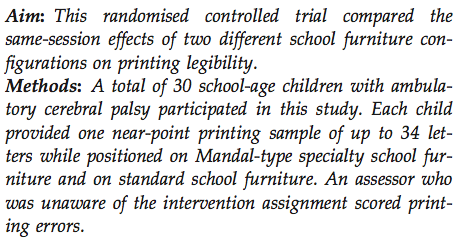12.7 Optional: Reading research articles
This question is optional; e.g., if you need more practice, or you are studying for the exam.
(Answers available in Sect. A.12)
Mastering handwriting is an important skill for children to learn, but children with cerebral palsy have a higher prevalence of handwriting problems.
One study (Ryan et al. 2010) examined the effect of handwriting legibility of children with cerebral palsy using two different types of configuration of the school desks ('standard' or 'speciality').
Each of the \(30\) students (aged \(6\) to \(8\) years old) used both desks. Legibility (and other aspects of handwriting) was assessed using the quantitative Minnesota Handwriting Assessment (MHA) scale.
Part of Table 1 in the paper is shown in Fig. 12.3.

FIGURE 12.3: Part of Table 1 in Ryan et al., 2010
- Read the extract in Fig. 12.4. Determine P, O, C and I (where possible) for this study.
- Identify the type of study being used. Is this a paired design or not?
Explain. - Identify the type of statistical technique that was probably used to compute the test information in Fig. 12.3.

FIGURE 12.4: Part of the Abstract in Ryan et al., 2010
Identify the units of observation and units of analysis.
Does the study use blinding? If so, for what reason? If not, why not?
What is the implication? What about double blinding?
Determine the sample mean and sample standard deviation for the scores when children use the standard furniture configuration.
Compute an approximate \(95\)% CI for the population mean legibility score when children use the standard furniture configuration.
Write down a statement communicating the results of the test comparing the two furniture configurations.
Based on this study, do you think the speciality desk improves handwriting legibility?